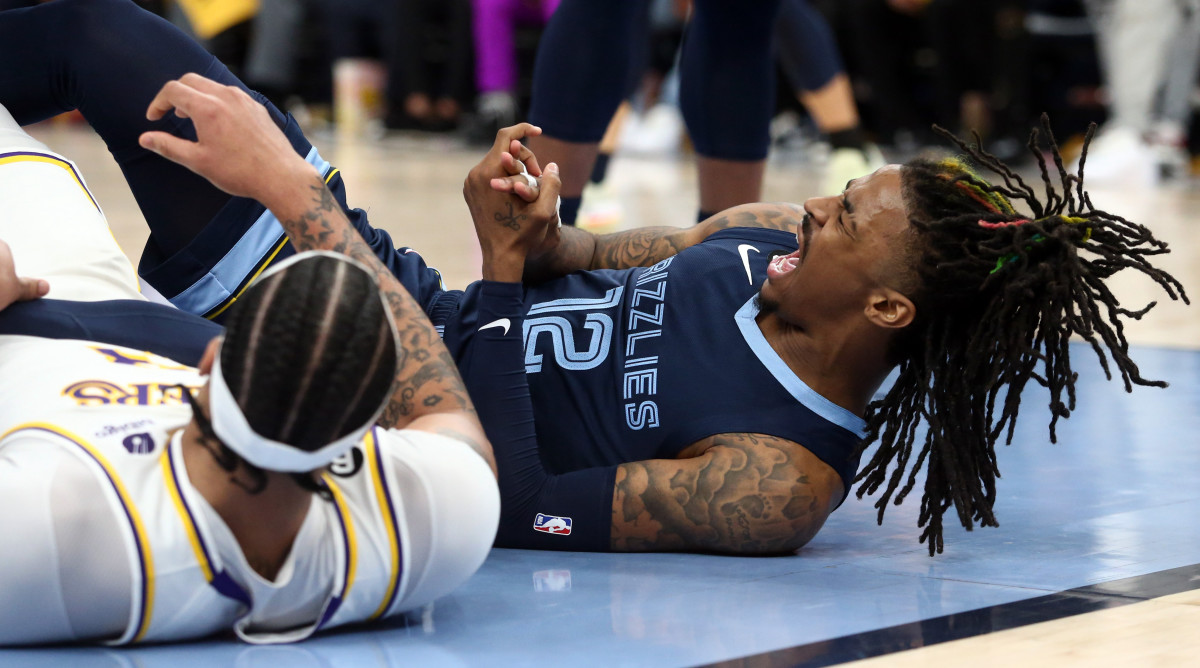It’s Time for a Change to the NBA’s Charging Rule

Before the first weekend of the NBA playoffs even concluded, we had a clear winner: Injuries.
Two-time league MVP Giannis Antetokounmpo and Grizzlies superstar Ja Morant both were forced to exit their playoff-opening contests Sunday after taking nasty falls when opposing players sought to draw charging calls against them. With Antetokounmpo’s back ailing, and Morant’s right hand in so much pain that he couldn’t untether a balled-up pair of socks, the entire postseason outlook potentially shifts. Case in point: The Bucks and Grizzlies dropped their respective Game 1s to No. 8 and No. 7 seeds, respectively, following the injuries. (Miami’s Tyler Herro, last year’s Sixth Man award winner, also got hurt, breaking his right hand.)
The timing of the maladies called into question whether the NBA’s charge/block rules make sense anymore in a league where speed and athleticism are greater than they’ve ever been. The reality is they don’t; at least not as they are written for the moment. Too much is riding on the shoulders of the star players who make these sorts of plays possible in the first place. There shouldn’t be an incentive for defensive players to position themselves in a way to invite that sort of highly risky contact several times per game.

There’s often confusion for players, coaches and fans alike on what constitutes a charge as opposed to a block. The clearest, most general way to explain a charge, according to league officials, is when a defender establishes himself in the path of an offensive player prior to contact occurring and before the offensive player shoots the ball. A defender has to be outside the restricted area to earn the call.
Here’s the problem with that logic, though: it allows defenders to slide into place—and sometime underneath an airborne offensive player—at the last millisecond, creating a dangerous situation for both people involved. At a minimum, the rule can and probably should be altered to require that defenders be set prior to offensive players gathering the ball to shoot or pass the ball, to give ballhandlers enough time to avoid contact that can result in such a nasty fall.
On Sunday, Morant, arguably the highest flyer in the entire league, had gathered the ball and was launching into a shot attempt when Lakers star Anthony Davis appeared to be establishing position in the paint to draw the charge. The result was an airborne Morant crashing to the ground and injuring his shooting hand. Though his X-ray came back negative, he described his pain as “about a 10,” and sounded highly unsure of whether he’d be able to play in Game 2.
Hours later, Heat big man Kevin Love—who ranked No. 2 in the league this season with 33 charges drawn—slid into the path of Antetokounmpo, who after colliding into Love while airborne fell squarely on his back and began writhing in pain. He returned shortly after and scored a basket, but then went to the locker room and was ruled out of the contest shortly after. Like Morant, Antetokounmpo’s X-ray came back negative, and his status is questionable going forward.
To be clear: Neither play was dirty. But to some extent, that’s the problem: With the current rules, defenders are incentivized to step in front of someone—and in doing so, possibly hurt them—instead of making a play on the ball. The two highly athletic megastars almost certainly wouldn’t have been injured on those plays if rules forced defenders to leap to contest attempts instead of sliding into place to beat a soon-airborne player to a given spot to draw a charge.
While it’s clear something needs to change, it’s also more than fair to suggest that simply removing the charge/block rules would make things too chaotic. The situation requires a nuanced approach. Would defenders have any chance of stopping someone like Giannis—or Morant, even—above the rim if they can’t jump as high? And if charges weren’t a thing anymore, would it simply embolden a player like Antetokounmpo to play even more physically?
Antetokounmpo—already the most relentlessly physical player in the NBA—has been called for an incredible 148 charges over the past five regular seasons. To put that into context, Julius Randle, the next closest player, has been whistled for 84. On one brutal play earlier this season, Antetokounmpo bulldozed through Suns forward Torrey Craig, a friend and former teammate.
The sequence left Craig without a tooth. “I actually ended up picking up multiple pieces of the tooth off the court,” Craig told me recently. “The dentist told me it makes the most sense to get it repaired after the season’s over. But Giannis is a really physical dude. So plays like that, I’m almost used to them. You can’t back up in a situation like that, or else he’ll just dunk on you.”
When I asked Antetokounmpo about the collisions—and how frequently he’s involved in them—earlier in the season, he responded by mentioning how often his coaches tell him they wish he’d do more to sell the contact he endures. “I don’t know how to sell it, though,” he told me. “I just try to play through contact, and [hope] it takes a toll on my opponent more than it does on me.”
But on Sunday, he didn’t need to sell anything. While the 34-year-old Love hopped right back up, Antetokounmpo, 28, had an actual, meaningful injury that threatened not only him, but the NBA title-favorite Bucks, too. And that reality, paired with Morant’s hand injury, should be enough for the league to give serious thought to altering the rules around charge/block calls.
